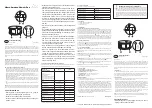
8
Installation
The PAX meets NEMA 4X/IP65 requirements when properly installed. The
unit is intended to be mounted into an enclosed panel. Prepare the panel cutout
to the dimensions shown. Remove the panel latch from the unit. Slide the panel
gasket over the rear of the unit to the
back of the bezel. The unit should
be installed fully assembled.
Insert the unit into the panel
cutout.
While holding the unit in place, push the panel latch over the rear of the unit
so that the tabs of the panel latch engage in the slots on the case. The panel
latch should be engaged in the farthest forward slot possible. To achieve a
proper seal, tighten the latch screws evenly until the unit is snug in the panel
(Torque to approximately 7 in-lbs [79N-cm]). Do not over-tighten the screws.
Installation Environment
The unit should be installed in a location that does not exceed the maximum
operating temperature and provides good air circulation. Placing the unit near
devices that generate excessive heat should be avoided.
The bezel should be cleaned only with a soft cloth and neutral soap product.
Do NOT use solvents. Continuous exposure to direct sunlight may accelerate
the aging process of the bezel.
Do not use tools of any kind (screwdrivers, pens, pencils, etc.) to operate the
keypad of the unit.
PANEL CUT-OUT
1.0 I
NSTALLING THE
M
ETER
2.0 S
ETTING THE
J
UMPERS
The meter can have up to four jumpers that must be checked and / or changed
prior to applying power. The following Jumper Selection Figures show an
enlargement of the jumper area.
To access the jumpers, remove the meter base from the case by firmly
squeezing and pulling back on the side rear finger tabs. This should lower the
latch below the case slot (which is located just in front of the finger tabs). It is
recommended to release the latch on one side, then start the other side latch.
Input Range Jumper
This jumper is used to select the proper input range. The input range selected
in programming must match the jumper setting. Select a range that is high enough
to accommodate the maximum input to avoid overloads. The selection is different
for each meter. See the Jumper Selection Figure for appropriate meter.
Excitation Output Jumper
If your meter has excitation, this jumper is used to select the excitation range
for the application. If excitation is not being used, it is not necessary to check or
move this jumper.
User Input Logic Jumper
This jumper selects the logic state of all the user inputs. If the user inputs are
not used, it is not necessary to check or move this jumper.
PAXH:
Signal Jumper
This jumper is used to select the signal type. For current signals, the jumper
is installed. For voltage signals, remove the jumper from the board. (For 2 V
inputs, this removed jumper can be used in the “2 V only” location.)
Couple Jumper
This jumper is used for AC / DC couple. If AC couple, then the jumper is
removed from the board. If DC couple is used, then the jumper is installed.
PAXD Jumper Selection
Main
Circuit
Board
JUMPER
LOCATION
JUMPER
LOCATION
CURRENT
EXCITATION
USER INPUT
VOLT/
OHM
JUMPER SELECTIONS
The
indicates factory setting.
Input Range Jumper
One jumper is used for voltage/ohms or current input ranges. Select the proper input range high
enough to avoid input signal overload. Only one jumper is allowed in this area. Do not have a jumper
in both the voltage and current ranges at the same time. Avoid placing the jumper across two ranges.
Содержание PAXCDL
Страница 28: ...27 PAX PROGRAMMING QUICK OVERVIEW PAXT O NLY ...










































